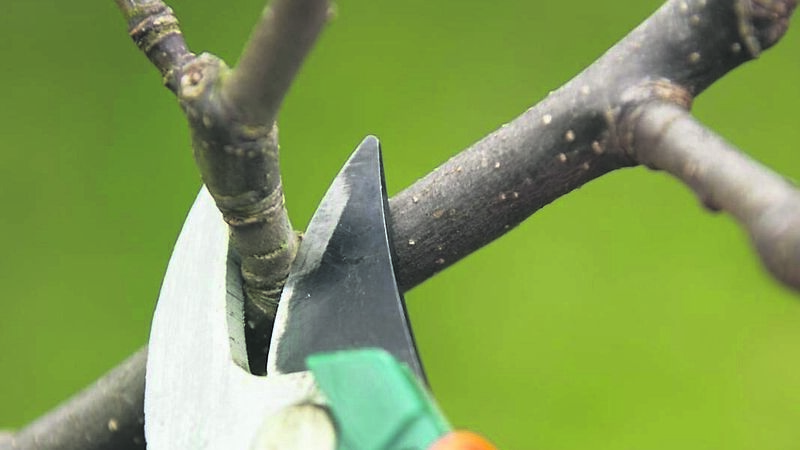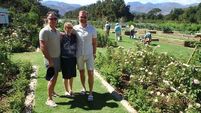In the Garden: It's pruning time for roses and apple trees

Pruning an apple tree with secateurs
IT is such a pleasure to walk out into the garden on a dry, sunny, crisp day to observe all of the new arrivals at this time of the year.
It seems to happen so suddenly, that plants burst into life, and it is very uplifting.
Realistically, though, there is some way to go yet regarding wet and cold weather so let us not get too complacent and get ahead of ourselves!
We can, however, admire the brave plants that start our growing year and encourage us out into the garden. The spring garden is a subtle one, with muted colours and smaller flowers on show. This makes finding a new one even more special.
The spring air is filled with the sweet scents of flowering spring shrubs now as well, providing us with another reason to venture out.
The birds are becoming more vocal in the mornings, and if you are lucky enough to have a pond in your garden, then the frog spawn watch has begun in earnest. Watching nature wake up gives great hope for new life and for the growing year ahead.
Once we get out and at it, then the planning for the year ahead begins, our own creative juices begin to flow once more, and the plotting and scheming for the 2023 growing season begins in earnest.
Snowdrops are responsible for a lot of hope in the garden early in the year and planting named varieties or the most commonly found Galanthus Nivalis in different areas of the garden is a reason for exploration and discovery each spring.
Crocus are becoming plentiful and daffodils are starting to appear in earnest now as well, and the tulips are peeping above the surface of the soil. Aconites produce strong yellow carpets on woodland floors, where they have become established and bring sunshine to the garden - a great spring stalwart.

In the midst of all of the glories of spring gardening, there are still jobs to be done and St Patrick’s Say is looming large - a traditional deadline each year in the garden, by which time certain pruning and other jobs need to be done. One job which needs to be completed in the next few weeks is pruning and feeding roses and fruit trees and bushes before they begin growth.
Top fruit like apples and pears will benefit from some winter pruning to control the size and shape, and promote better quality fruit and control disease. The best tools for the job are a long handled loppers, secateurs and a pruning saw.
The first step is to stand back and look at the overall shape of the tree and decide what you need to achieve.
Has the tree become too tall? Are there crossing branches that need to be removed? Are there diseased branches that need to be removed?
Come up with a plan for pruning the tree and then start to execute it slowly.
If a tree has been neglected for a few years, it may be better to implement a plan gradually over 3-5 years.
There is an old saying that states that, to prune an apple tree well, a bird should be able to fly through without its wings touching the branches. For good air circulation and light, it is best to have an open urn shape. Remove any dead, diseased or damaged branches first.
Canker is a fungal disease affecting apple trees and it can usually be controlled quite effectively by cutting out any infected branches to prevent the spread of the disease.
It is important to sterilize pruning tools regularly to prevent the spread of the disease. Surgical spirits can be used to wipe tools clean, it is quick and effective.
Then stand back and look again. Next, look at reducing any new growth (pencil thick growth) down by half or two thirds to control the size of the tree.
Maintaining a tree at a convenient height for harvesting is an important consideration. Fruit trees can be purchased grafted onto different root stocks which control the height of the tree. M9, M26 and M27 all produce compact tree sizes, with MM106 and MM111 producing taller trees, so consider this when purchasing any fruit tree for the garden.
Fruit buds can be identified by their shape and size, they are generally fatter and rounder than leaf buds and can occur in clusters or spurs.
Any spurs that are too congested or over-crowded may need to be thinned and any dead or diseased spurs removed.
Maintaining five or six main branches as the framework for an apple tree and keeping the growth coming off of this main framework open and airy will produce the best conditions for healthy growth and ripening of fruit.
When pruning, always try to prune to an outward facing bud in an attempt to create an open centre by encouraging any new growth that will emerge to grow outwards.
Happy Fruit Pruning!

Plant of the Week
Acacia dealbata, mimosa or silver wattle, can be one of the first indicators of spring with its vibrant fluffy fragrant yellow flowers borne in February.
It a native to Australia and prefers a neutral to acid soil. It has evergreen grey/green finely cut leaves and could be considered a large shrub or a small tree, getting to a height of about 12 metres and a spread of 4-6 metres in time.
It will do best in a sheltered south facing, well drained site. It would require protection in the winter in colder parts of the country.
This plant has an extensive rooting system which makes it a very vigorous plant and quick to establish growing in the right conditions.
The early pollen rich flowers will be a welcome addition for early flying pollinators in the garden.







 App?
App?


